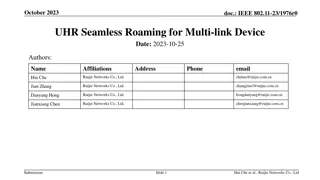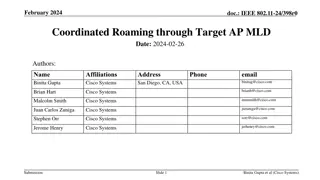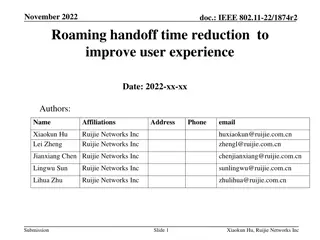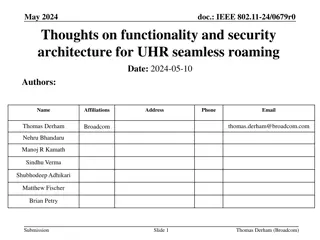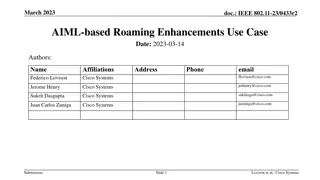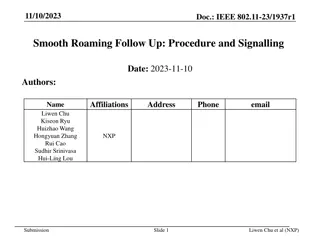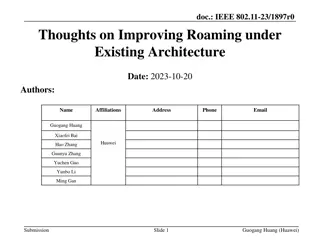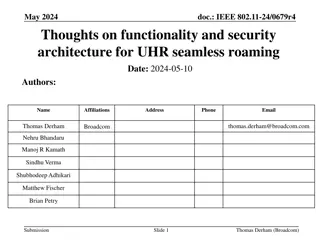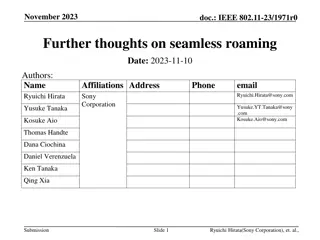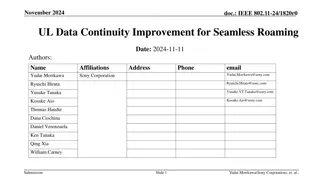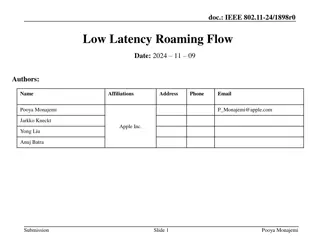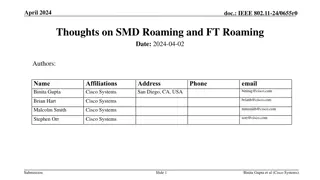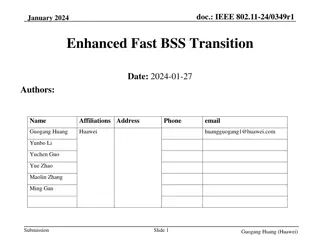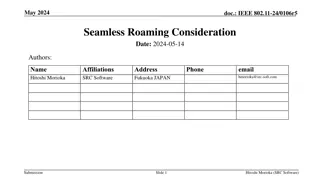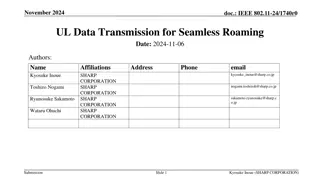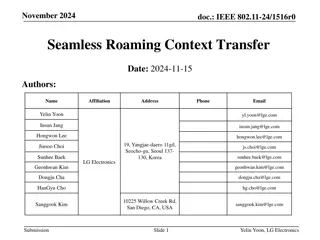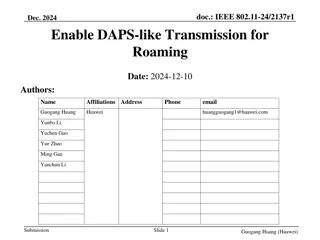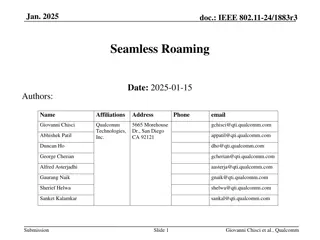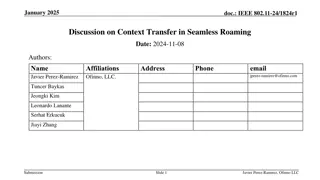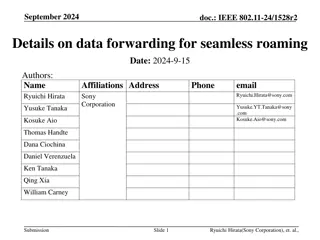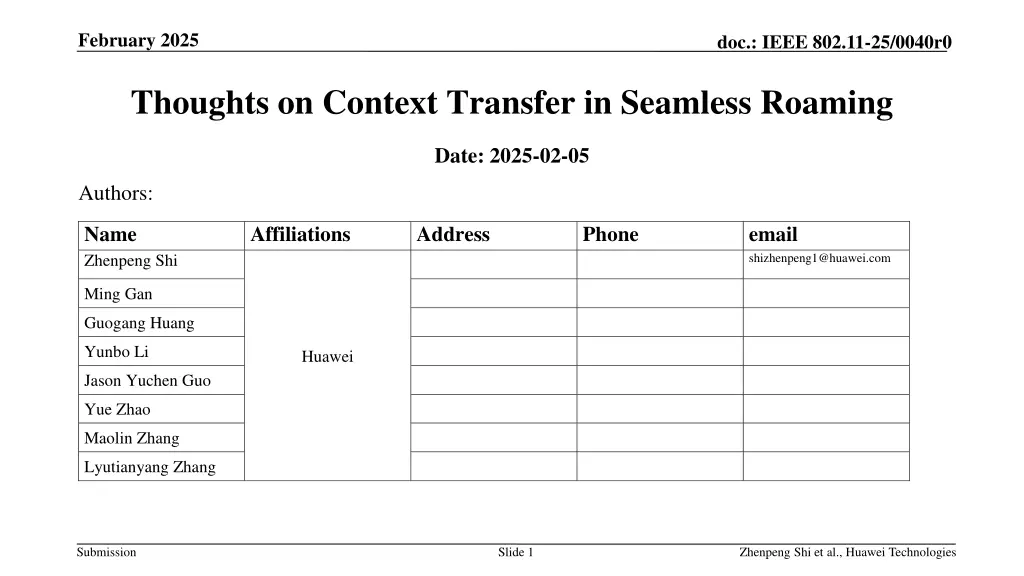
Insights on Context Transfer for Seamless Roaming in IEEE 802.11-25
Explore the concept of context transfer and renegotiation for seamless roaming in IEEE 802.11-25 communication standards. The document discusses the transfer of static and dynamic contexts between access points to enhance connectivity while addressing challenges like ping-pong roaming. Discover solutions to reduce overhead during roaming transitions.
Download Presentation

Please find below an Image/Link to download the presentation.
The content on the website is provided AS IS for your information and personal use only. It may not be sold, licensed, or shared on other websites without obtaining consent from the author. If you encounter any issues during the download, it is possible that the publisher has removed the file from their server.
You are allowed to download the files provided on this website for personal or commercial use, subject to the condition that they are used lawfully. All files are the property of their respective owners.
The content on the website is provided AS IS for your information and personal use only. It may not be sold, licensed, or shared on other websites without obtaining consent from the author.
E N D
Presentation Transcript
February 2025 doc.: IEEE 802.11-25/0040r0 Thoughts on Context Transfer in Seamless Roaming Date: 2025-02-05 Authors: Name Zhenpeng Shi Affiliations Address Phone email shizhenpeng1@huawei.com Ming Gan Guogang Huang Yunbo Li Huawei Jason Yuchen Guo Yue Zhao Maolin Zhang Lyutianyang Zhang Submission Slide 1 Zhenpeng Shi et al., Huawei Technologies
February 2025 doc.: IEEE 802.11-25/0040r0 Introduction 11bn has agreed to support context transfer and context renegotiation for seamless roaming [Motion #26] TGbn defines that when a non-AP MLD is in the process of roaming from the current AP MLD to a target AP MLD, the context related to the non-AP MLD is transferred to the target AP MLD such that it preserves the data exchange context for the non-AP MLD or the context can be renegotiated with the target AP MLD. Details on what context can be transferred and what context can be renegotiated are TBD. How to transfer the context is TBD. [Motion #162] As part of the seamless roaming procedure, before the request/response exchange requesting the roaming transition from a current AP MLD to a target AP MLD, a roaming preparation procedure can be performed that includes: Transfer or renegotiation of the context to a target AP MLD, and Setting up the link(s) with a target AP MLD. Details on what context can be transferred or renegotiated is TBD Submission Slide 2 Zhenpeng Shi et al., Huawei Technologies
February 2025 doc.: IEEE 802.11-25/0040r0 Introduction Non-AP MLD AP MLD 1 AP MLD 2 Context can be transferred to target AP MLD to reduce overhead Static context: BA agreement, SCS/MSCS, TWT, Dynamic context: SN Context can also be renegotiated with target AP MLD Context transfer/renegotiation can happen in different roaming phases Static context can be transferred/renegotiated in both preparation phase and transition phase Dynamic context can be transferred in transition phase In this contribution, we discuss several aspects of context transfer and renegotiation FT Multi-link Setup Request Preparation Phase Static Context Transfer Multi-link Setup FT Multi-link Setup Request Roaming Request Transition Phase Dynamic Context Transfer Roaming Response *Naming of the request/response above is TBD Submission Slide 3 Zhenpeng Shi et al., Huawei Technologies
February 2025 doc.: IEEE 802.11-25/0040r0 Ping-pong roaming problem In some scenarios, non-AP MLD may roam between two AP MLDs back and forth e.g., AP MLD s signal fluctuates around roaming threshold It is difficult to completely avoid ping-pong roaming from happening Non-AP MLD may realize it only after roaming between two AP MLDs a few times Context needs to be transferred or negotiated every time Results in additional overhead If ping-pong roaming happens, how to reduce this overhead? Submission Slide 4 Zhenpeng Shi et al., Huawei Technologies
February 2025 doc.: IEEE 802.11-25/0040r0 Context preserve by current AP MLD Non-AP MLD AP MLD 1 AP MLD 2 To minimize context to be transferred or renegotiated in ping-pong roaming scenario, we propose: Current AP MLD preserves context of non-AP MLD within a timeout after roaming is completed or retrieval of buffered DL data is finished Including BA, SCS/MSCS, TWT, ... PTKSA and the setup links between current AP MLD and non-AP MLD can also be preserved Context preserve timeout can be BSS max idle period, or Reassociation deadline (as used in FT), or Defined as a new parameter and carried in Timeout Interval Element Overhead of preparation phase is reduced if non-AP MLD decides to roam back to current AP MLD within the timeout FT Multi-link Setup Request Preparation Phase 1 Static Context Transfer Multi-link Setup FT Multi-link Setup Request Roaming Request Transition Phase 1 Dynamic Context Transfer Roaming Response Roaming Request Transition Phase 2 Context Transfer (if needed) Roaming Response Submission Slide 5 Zhenpeng Shi et al., Huawei Technologies
February 2025 doc.: IEEE 802.11-25/0040r0 Context transfer indication By default, non-AP MLD may assume context transfer from current AP MLD to target AP MLD is successful However, target AP MLD may reject some transferred context due to limited capability e.g., SCS, TWT, etc. Non-AP MLD can indicate whether/what context needs to be transferred Context transfer result needs to be indicated to non-AP MLD in roaming response In this way, non-AP MLD knows which context is maintained and which needs renegotiation Target AP MLD can provide context suggestion for rejected context e.g., TWT recommended by target AP MLD Non-AP MLD can use it for efficient renegotiation Submission Slide 6 Zhenpeng Shi et al., Huawei Technologies
February 2025 doc.: IEEE 802.11-25/0040r0 Roaming deadline update After roaming preparation (static context transfer and multi-link setup) is completed, non- AP MLD needs to initiate roaming transition before a roaming deadline to avoid target AP MLD reserving resources for non-AP MLD for a long time In FT, this is captured by Reassociation Deadline Similar timeout has been proposed [3,11] However, non-AP MLD might not be able to initiate roaming by the initial deadline e.g., due to IDC, OBSS interference, fluctuating signal strength, etc. Non-AP MLD may want to extend the deadline, to avoid overhead of repeating roaming preparation Or early terminate roaming, to release reserved resources at target AP MLD A mechanism can be defined for non-AP MLD to request updating roaming deadline Allows non-AP MLD to flexibly adjust roaming deadline based on its needs Submission Slide 7 Zhenpeng Shi et al., Huawei Technologies
February 2025 doc.: IEEE 802.11-25/0040r0 Conclusion In this contribution, we have discussed several aspects of context transfer and renegotiation in seamless roaming To reduce overhead in some roaming scenarios, we propose Current AP MLD preserves context about non-AP MLD within a timeout after roaming is completed or retrieval of buffered DL data is finished Context transfer result is indicated to non-AP MLD, optionally with suggestions by target AP MLD Non-AP MLD can request to update deadline for initiate roaming Submission Slide 8 Zhenpeng Shi et al., Huawei Technologies
February 2025 doc.: IEEE 802.11-25/0040r0 References 1. 2. 3. 4. 5. 6. 7. 8. 9. 10. 11-24-1824-00-00bn-discussion-on-context-transfer-in-seamless-roaming 11. 11-24-1883-00-00bn-seamless-roaming 11-24-0052-00-00bn-seamless-roaming-details 11-24-0349-03-00bn-enhanced-fast-bss-transition 11-24-0396-02-00bn-seamless-roaming-within-a-mobility-domain-follow-up 11-24-0480-00-00bn-details-on-context-transfer-and-data-forwarding-under-ft-protocol 11-24-0679-01-00bn-thoughts-on-functionality-and-security-architecture-for-uhr-seamless-roaming 11-24-0830-00-00bn-improve-roaming-between-mlds-follow-up 11-24-0881-00-00bn-improving-stability-during-roaming-process 11-24-1425-00-00bn-considerations-for-context-transfer-in-11bn 11-24-1746-01-00bn-comparision-between-enhanced-fast-bss-transition-and-smd Submission Slide 9 Zhenpeng Shi et al., Huawei Technologies

